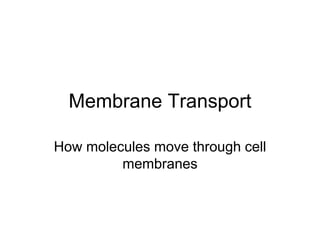
Plasma type membrane.ppt
- 1. Membrane Transport How molecules move through cell membranes
- 2. • Where can you find membranes in a cell? • What are the functions of the cell membrane? • What is a semipermeable membrane?
- 3. Membranes are found around the cell and each organelle
- 5. • The cell boundary; separates cellular materials from external environment • Regulates which materials can enter and exit the cell • Maintains homeostasis in cell
- 6. Semipermeable membranes • Membranes that allow certain materials to pass through based on certain properties – size – hydrophobicity – charge
- 7. The Fluid Mosaic Model: The membrane is made up of many smaller parts and the structure moves like a fluid • http://www.susanahalpine.com/anim/Life/memb.htm
- 8. Phospholipids and proteins make up most of the membrane. Cholesterol helps with flexibility, and carbohydrate chains help communicate with other cells
- 9. A phospholipid is a type of lipid that has 2 fatty acid tails and a phosphate head. • http://telstar.ote.cmu.edu/Hughes/tuto rial/cellmembranes/ The phosphate head is hydrophilic because it is attracted to water The fatty acid tails are hydrophobic Because they are repelled by water Use E-Life animation 6.3 https://www.youtube.com/watch?v=pzpZdijj qX8
- 10. The phospholipid bilayer forms because the inside and outside of the cell are mostly water:
- 11. A cell membrane has many properties in common with bubbles!
- 12. Clean up: • Pour soap down drain • Rinse plate, straw frame and beaker VERY well • Throw out used straws and thread ring • Return plate, straw frame and beaker • Wipe down table top VERY well
- 13. The phospholipid bilayer is a semipermeable membrane because it only allows certain molecules to cross.
- 14. Hydrophilic, polar, large and charged molecules must use a Transport Protein to enter/exit the cell. The proteins are specific; glucose can only pass through a glucose transport protein.
- 15. There are two types of Transport Proteins: Protein Channels: a special entryway for large, polar, hydrophilic and charged ions to diffuse through the cell membrane This is called Facilitated Diffusion. Protein Pumps: we’ll talk about these later
- 16. The Big Idea 1. Name 4 components of the cell membrane 2. What kind of molecules CAN go through the phospholipid bilayer? 3. What kinds of molecules CANNOT go through the phospholipid bilayer? 4. What is facilitated diffusion? 5. Can any molecule go through any protein channel? 6. When will the molecules stop noticeably moving?
- 17. Describe a person who is passive. Describe a person who is active.
- 18. Passive Transport: > Materials move down the concentration gradient from high to low solution concentrations > Equilibrium is reached (concentrations are equal all around) > No energy (ATP) is needed by the cell to move the materials
- 19. Active Transport: 1. Materials move up the concentration gradient, from low to high solution concentrations 2. Concentrations become unbalanced on either side of the membrane 3. Energy (ATP) is needed by the cell to move the materials
- 20. Diffusion Facilitated Diffusion Osmosis 1. Passive Transport Protein Pumps Endocytosis Exocytosis 2. Active Transport There are two ways that materials can move in/out of the cell
- 21. 1. Protein Pumps use energy (ATP, electrons) to increase the concentration on one side of the membrane
- 22. The Sodium-Potassium (Na+/K+) Pump uses ATP to move Na+ out and K+ into nerve, muscle and many other cells.
- 23. Protein pumps are found cooperating with protein channels in photosynthesis and cell respiration
- 24. 2. Endocytosis: Materials enter the cell without crossing the membrane—the membrane folds around the particles and forms a new vacuole inside the cell
- 25. Amoeba and white blood cells engulf large food particles through phagocytosis (a type of endocytosis). http://www.youtube.com/watch?v=pvOz4V 699gk (mute: annoying soundtrack)
- 27. 3. Exocytosis: Vesicles fuse to the cell membrane to release their contents (cell products or waste)
- 28. Phospholipids from vesicle membranes integrate into the plasma membrane
- 30. 1. What materials can diffuse through the lipid bilayer without the aid of a protein? 2. What is the difference between facilitated diffusion and the use of a protein pump? 3. What are the major differences between Passive Transport and Active Transport? 4. Explain why an animal cell bursts when placed in a hypotonic solution.